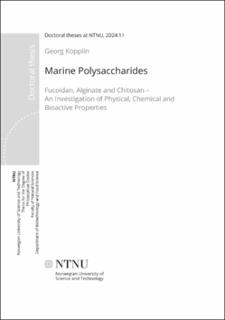| dc.contributor.advisor | Aachmann, Finn L. | |
| dc.contributor.advisor | Skjåk-Bræk, Ola Gudmund | |
| dc.contributor.author | Kopplin, Georg | |
| dc.date.accessioned | 2024-01-30T09:23:14Z | |
| dc.date.available | 2024-01-30T09:23:14Z | |
| dc.date.issued | 2024 | |
| dc.identifier.isbn | 978-82-326-7623-1 | |
| dc.identifier.issn | 2703-8084 | |
| dc.identifier.uri | https://hdl.handle.net/11250/3114441 | |
| dc.description.abstract | The marine polysaccharides fucoidan, alginate and chitosan are garnering significant research interest in the field of biomedical applications due to their broad range of bioactivities, compatibility with living tissues and their ability to form hydrogels. This thesis presents in-depth investigations of the chemical, physical, and bioactive properties, and potential applications of these marine polysaccharides.
The chemical structure of fucoidan from Laminaria hyperborea was elucidated utilizing numerous analytical techniques, including NMR spectroscopy, SEC-MALS, Raman and IR spectroscopy, ICP-MS and glycosidic linkage analysis. Highly purified fucoidan was used to investigate bioactivity in vitro using a lepirudin-based human whole blood model as well as human-derived cell lines from uveal melanoma, retinal pigment epithelium and porcine-derived primary cells from retinal pigment epithelium. Structural features such as the degree of sulfation and molecular weight were tailored to enable elucidation of structure–function relationships.
Unmodified fucoidan with a high degree of sulfation and molecular weight was demonstrated to inhibit coagulation at intermediate to high concentrations, showing similar inhibitory effects on the complement system. Experiments on the ocular cell lines unveiled a positive relationship between molecular weight, bioactivity, and potential therapeutic effects for highly sulfated fucoidan. The work underscores the importance of both molecular weight and the degree of sulfation as key parameters for bioactive properties.
Alginate hydrogels which are attractive biomaterials for applications such as cell encapsulation, tissue engineering, coatings, and drug delivery, were examined on a fundamental scientific level. Through CD spectroscopy and molecular dynamic simulations, we obtained strong evidence supporting a previously hypothesised zipper-like junction zone formation between alginate M-blocks and chitosan.
Furthermore, we developed and investigated a novel alginate-chitosan gelling system. This system relies upon crosslinks between poly-MG-blocks and chitosan oligomers and can enable gel strengths orders of magnitude higher than those observed in poly-M-chitosan hydrogels. Rheological measurements and molecular dynamic simulations suggested a fundamentally different chain–chain interaction mechanism involving localized phase-separation.
Gels made from alginates with different block structures were crosslinked with combinations of calcium and chito-oligosaccharides. We found that up to 50% of Ca2+ can be replaced by chitosan oligomers (under specific conditions) without compromising gel strength or the occurrence of syneresis, while simultaneously increasing the rate of gelation. The inclusion of chitosan oligomers in the gelation mechanism allows for customizing gelling kinetics and may enhance hydrogel stability against electrolytes, a factor of great importance in biomedical applications. | en_US |
| dc.language.iso | eng | en_US |
| dc.publisher | NTNU | en_US |
| dc.relation.ispartofseries | Doctoral theses at NTNU;2024:11 | |
| dc.relation.haspart | Paper 1: Feng, Yiming; Kopplin, Georg; Sato, Kimihiko; Draget, Kurt Ingar; Vårum, Kjell Morten. Alginate gels with a combination of calcium and chitosan oligomer mixtures as crosslinkers. Carbohydrate Polymers 2017 ;Volum 156. s. 490-497. © 2016 Elsevier Ltd. All rights reserved. Available at: http://dx.doi.org/10.1016/j.carbpol.2016.09.006 | en_US |
| dc.relation.haspart | Paper 2: Kopplin, Georg; Rokstad, Anne Mari; Mélida, Hugo; Bulone, Vincent; Skjåk-Bræk, Gudmund; Aachmann, Finn Lillelund. Structural characterization of fucoidan from Laminaria hyperborea: Assessment of coagulation and inflammatory properties and their structure−function relationship. ACS Applied Bio Materials (AABM) 2018 ;Volum 1.(6) s. 1880-1892. Published by American Chemical Society. This publication is Open Access under a an ACS Author Choice License. Available at: http://dx.doi.org/10.1021/acsabm.8b00436 | en_US |
| dc.relation.haspart | Paper 3: Dorschmann, Philipp; Kopplin, Georg; Roider, Johann; Klettner, Alexa. Effects of Sulfated Fucans from Laminaria hyperborea Regarding VEGF Secretion, Cell Viability, and Oxidative Stress and Correlation with Molecular Weight. Marine Drugs 2019 ;Volum 17.(10) s. 1-14. Published by MDPI. This article is an open access article distributed under the terms and conditions of the Creative Commons Attribution CC BY. Available at: http://dx.doi.org/10.3390/md17100548 | en_US |
| dc.relation.haspart | Paper 4: Kopplin, Georg; Lervik, Anders; Draget, Kurt Ingar; Aachmann, Finn Lillelund. Alginate gels crosslinked with chitosan oligomers - a systematic investigation into alginate block structure and chitosan oligomer interaction. RSC Advances 2021 ;Volum 11.(23) s. 13780-13798. Published by Royal Society of Chemistry. This article is licensed under a Creative Commons Attribution CC BY. Available at: http://dx.doi.org/10.1039/d1ra01003d | en_US |
| dc.title | Marine Polysaccharides: Fucoidan, Alginate and Chitosan – An Investigation of Physical, Chemical and Bioactive Properties | en_US |
| dc.type | Doctoral thesis | en_US |
| dc.subject.nsi | VDP::Teknologi: 500::Næringsmiddelteknologi: 600 | en_US |
